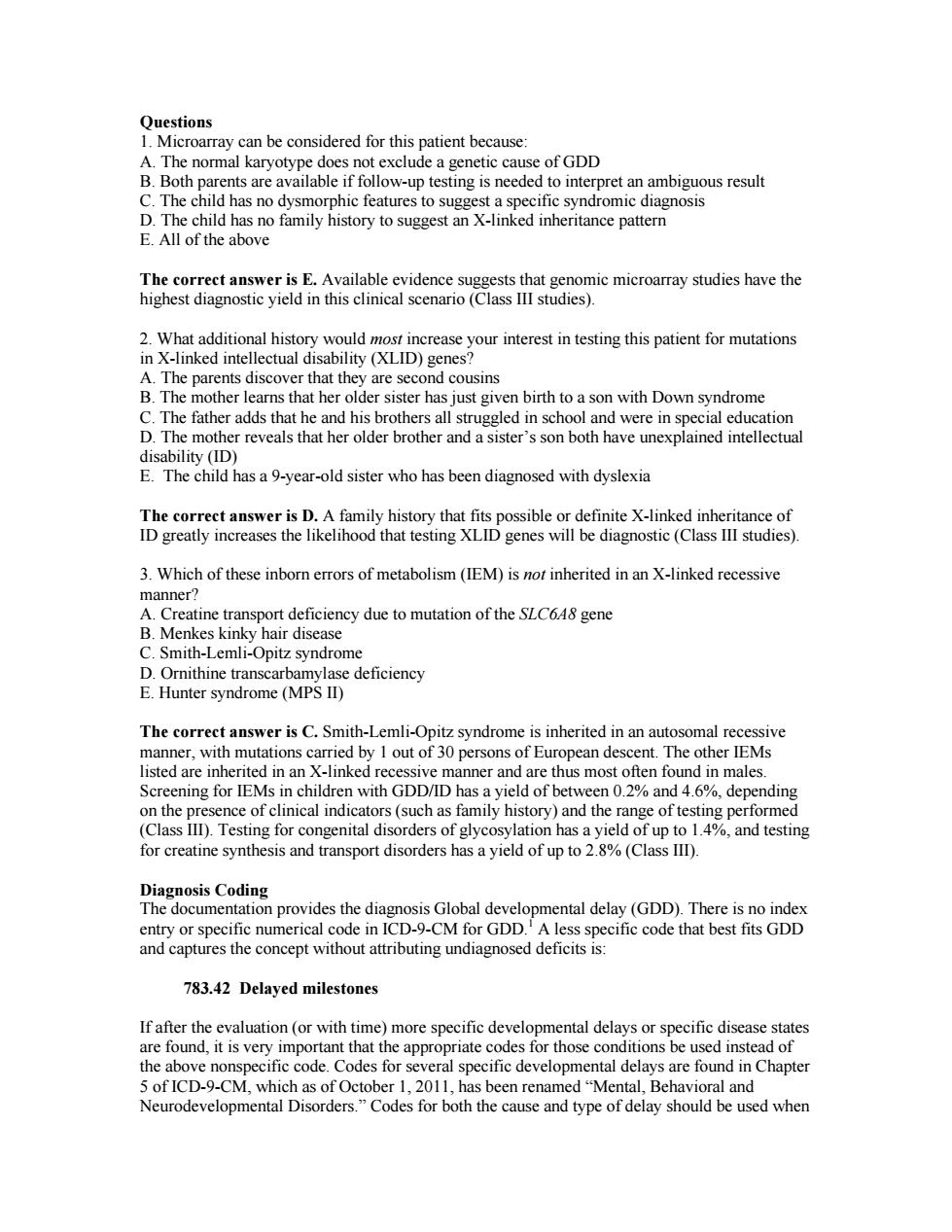正在加载图片...

ons A Th ara ka n be considered for this patient because ofGDD B Both if follow-up testing is needed to int ret an ambiguous result C.The child has no dysmorphic features to suggest a specific syndromic diagnosis D.The child has no family history to suggest an X-linked inheritance pattern E.All of the above The correct ar y ailable evidence sum microarray studies have th 2 What additional histo nLsnrs i esting this patient for muatio A.The parents discover that they are second cousins B.The mother learns that her older sister has just given birth to a son with Down syndrome The father adds that he and his brothers all struggled in school and were in spectal cducation mo er reveals that her older brother and a sister's son both have unexplained intellectual The correct answer is D.A family history that fits possible or definite X-linked inheritance of ID greatly increases the likelihood that testing XLID genes will be diagnostic (Class IlI studies). 3.Which of these inborn errors of metabolism(IEM)is not inherited in an X-linked recessive manner? sport deficiency due to mutation of the gene C Sm ndr D.Ornithine nscarbamylase deficiency E.Hunter syndrome (MPS The correct answer is C.Smith-Lemli-Opitz syndrome is inherited in an autosomal recessive manner,wit h mu isted are i of 30 persons of European descent.The other IEMs manner an are us mos for ren with GD nd th ependin (Class ID.Testing for cong ital disorders of glyc svlation has a vield of up to 14%,and testing for creatine synthesis and transport disorders has a yield of up to 2.8%(Class II). Diagnosis Coding nprovides the diagnosis Global developmental delay(GDD).I ode in ICD-9 less specific code that best fits GDD captures the concept without attributing undiagnosed defici 783.42 Delayed milestones If after the evaluation(or with time)more specific developmental delays or specific disease states are found,it is very important that the appropriate codes for those conditions be used instead of the above nonspecific code.Codes for several specific developmental delays are found in Chapter ch as of October 1,2011,has been renamed "Me es Ior t h the cause and type of delay should be used whe Questions 1. Microarray can be considered for this patient because: A. The normal karyotype does not exclude a genetic cause of GDD B. Both parents are available if follow-up testing is needed to interpret an ambiguous result C. The child has no dysmorphic features to suggest a specific syndromic diagnosis D. The child has no family history to suggest an X-linked inheritance pattern E. All of the above The correct answer is E. Available evidence suggests that genomic microarray studies have the highest diagnostic yield in this clinical scenario (Class III studies). 2. What additional history would most increase your interest in testing this patient for mutations in X-linked intellectual disability (XLID) genes? A. The parents discover that they are second cousins B. The mother learns that her older sister has just given birth to a son with Down syndrome C. The father adds that he and his brothers all struggled in school and were in special education D. The mother reveals that her older brother and a sister’s son both have unexplained intellectual disability (ID) E. The child has a 9-year-old sister who has been diagnosed with dyslexia The correct answer is D. A family history that fits possible or definite X-linked inheritance of ID greatly increases the likelihood that testing XLID genes will be diagnostic (Class III studies). 3. Which of these inborn errors of metabolism (IEM) is not inherited in an X-linked recessive manner? A. Creatine transport deficiency due to mutation of the SLC6A8 gene B. Menkes kinky hair disease C. Smith-Lemli-Opitz syndrome D. Ornithine transcarbamylase deficiency E. Hunter syndrome (MPS II) The correct answer is C. Smith-Lemli-Opitz syndrome is inherited in an autosomal recessive manner, with mutations carried by 1 out of 30 persons of European descent. The other IEMs listed are inherited in an X-linked recessive manner and are thus most often found in males. Screening for IEMs in children with GDD/ID has a yield of between 0.2% and 4.6%, depending on the presence of clinical indicators (such as family history) and the range of testing performed (Class III). Testing for congenital disorders of glycosylation has a yield of up to 1.4%, and testing for creatine synthesis and transport disorders has a yield of up to 2.8% (Class III). Diagnosis Coding The documentation provides the diagnosis Global developmental delay (GDD). There is no index entry or specific numerical code in ICD-9-CM for GDD.1 A less specific code that best fits GDD and captures the concept without attributing undiagnosed deficits is: 783.42 Delayed milestones If after the evaluation (or with time) more specific developmental delays or specific disease states are found, it is very important that the appropriate codes for those conditions be used instead of the above nonspecific code. Codes for several specific developmental delays are found in Chapter 5 of ICD-9-CM, which as of October 1, 2011, has been renamed “Mental, Behavioral and Neurodevelopmental Disorders.” Codes for both the cause and type of delay should be used when